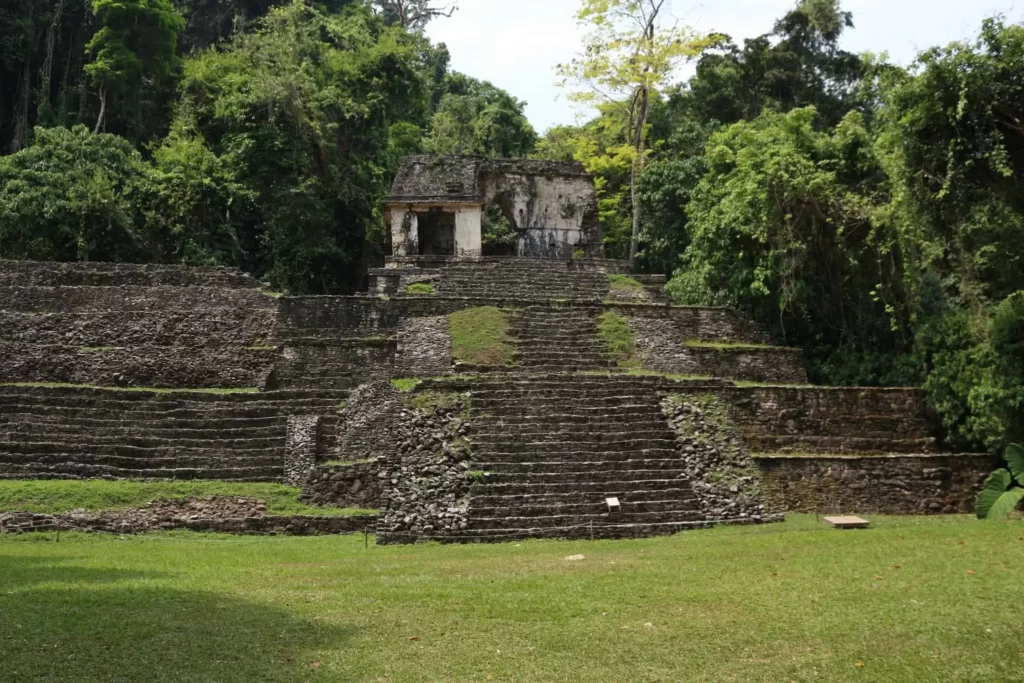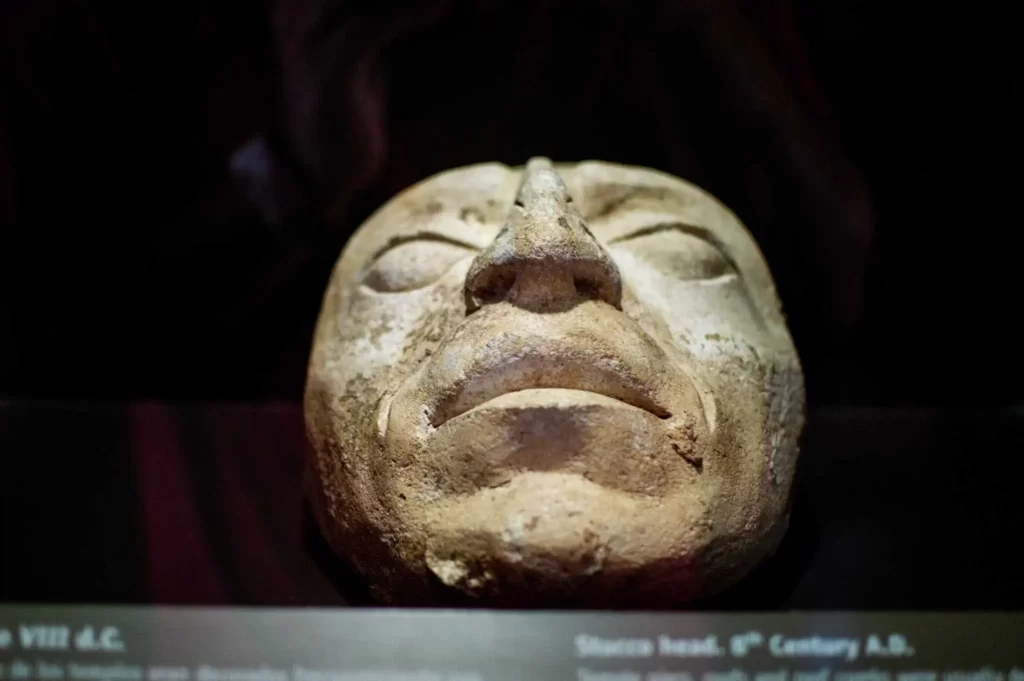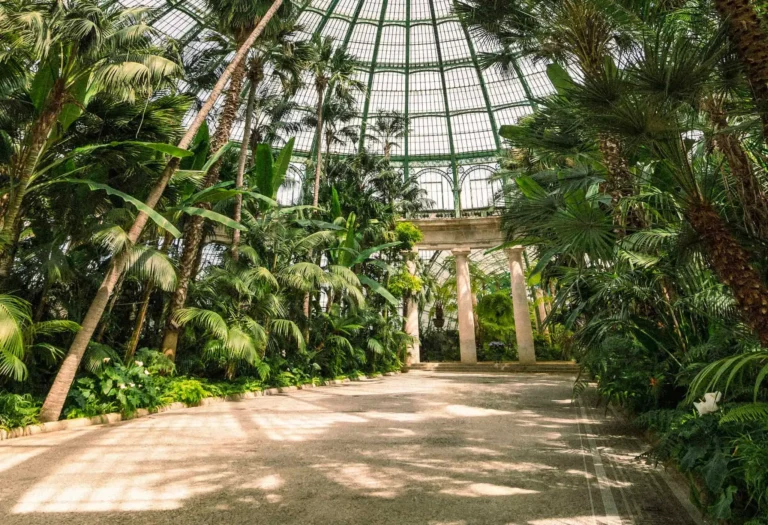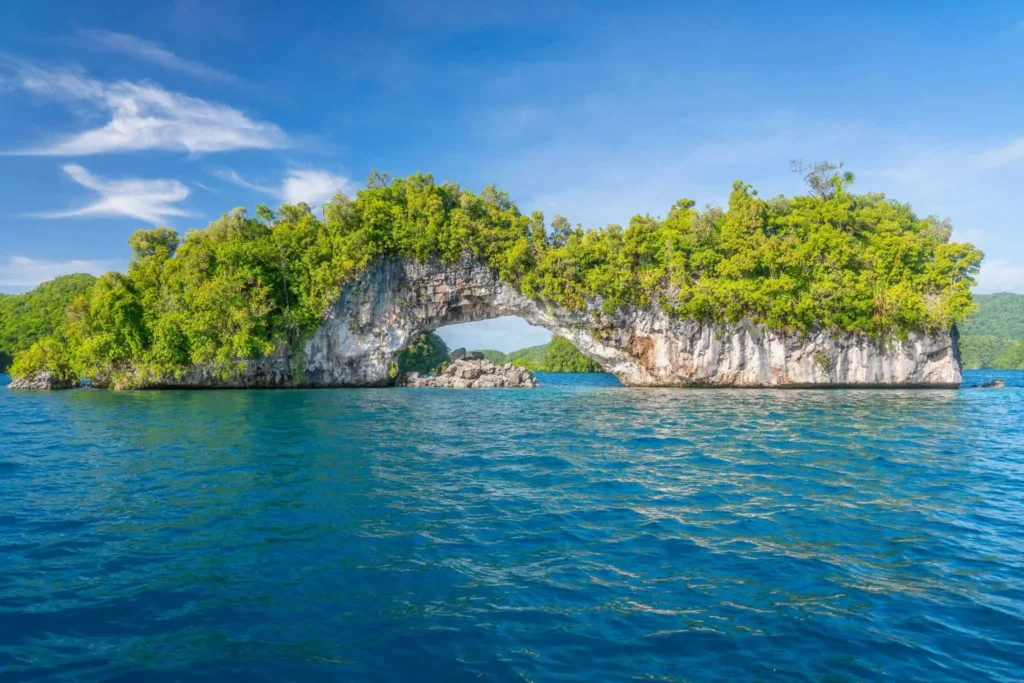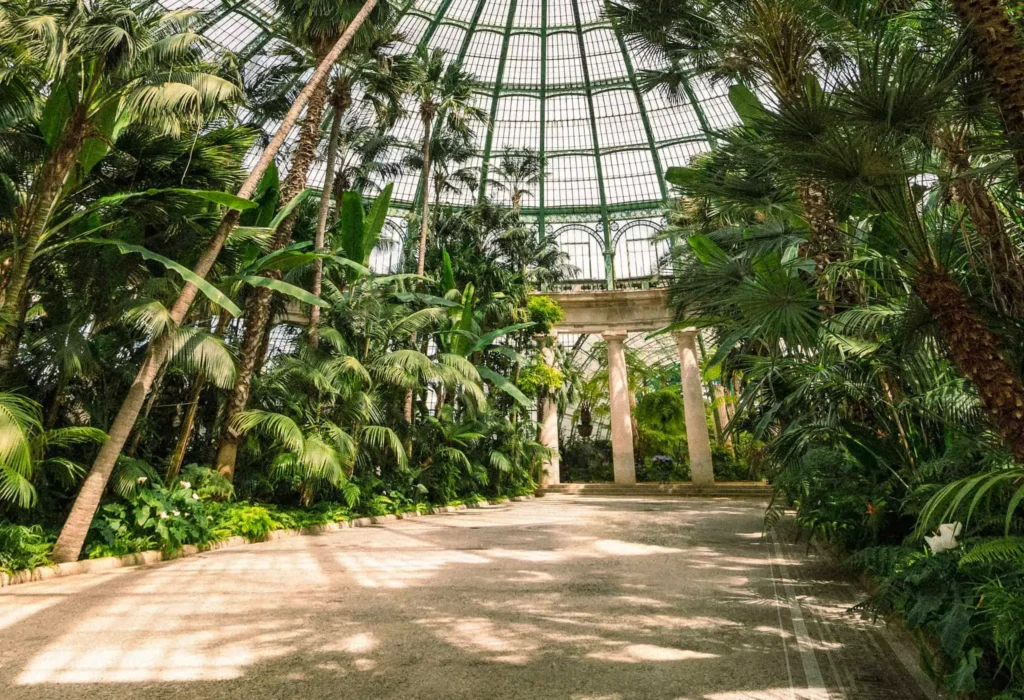| This post may contain affiliate links. Whenever you book or buy something through one of these, Giving Getaway gets a small commission, of which 100% will be donated to charity, without any extra cost to you! |
Palenque, located in modern-day Mexico, was once a thriving metropolis of the ancient Maya civilization. Its rich history and well-preserved structures have made it an archaeological paradise for researchers and history enthusiasts alike. Reason enough for me to take a closer look at this mysterious place and to compile a list of 10 fascinating facts about Palenque.
From its magnificent temples to its intricate artwork, every corner of Palenque has a story to tell. Join me as I unravel the mysteries behind Palenque and let’s dive into what it is that makes Palenque such an intriguing place!
Key Takeaways
- Palenque was one of the most prominent cities in the Mayan civilization, flourishing during the Late Classic period.
- The city is renowned for its impressive architectural feats, including the well-preserved Temple of Inscriptions.
- Palenque’s inscriptions and hieroglyphics provide valuable insights into the Mayan civilization, covering various topics such as historical events and religious rituals.
- The rediscovery of Palenque in the 18th century has significantly contributed to the understanding of Mesoamerican civilizations.
1) Palenque Was One of the Most Important Cities in the Mayan Civilization
Palenque’s significance within the Mayan civilization is evident as it served as one of the most prominent cities. Located in what is now modern-day Mexico, Palenque flourished during the Late Classic period of Mayan history, from around 600 to 900 AD. It was a center of political, economic, and religious power in the region.
One of the key factors that contributed to Palenque’s importance was its strategic location. Situated in a fertile valley surrounded by hills and mountains, it had access to natural resources such as water and agricultural land. This allowed for a thriving population and supported the development of complex social structures.
Palenque also played a crucial role in trade networks throughout Mesoamerica. Its location near important river systems facilitated transportation and exchange of goods with neighboring regions. Excavations at Palenque have revealed evidence of imported luxury items, such as jade and obsidian, indicating its involvement in long-distance trade.
Furthermore, Palenque was known for its impressive architectural feats. The city is home to numerous grand temples, palaces, and other monumental structures that showcase advanced engineering techniques and artistic mastery. One notable example is the Temple of Inscriptions, which houses an intricate hieroglyphic text detailing the life and achievements of one of Palenque’s most famous rulers – King Pakal.
2) The Site Is Known for Its Well-Preserved Inscriptions and Hieroglyphics
The site in Mexico is known for its exceptional collection of inscriptions and hieroglyphics that provide valuable insights into the Mayan civilization. These inscriptions are found on various structures within site, including temples, palaces, and tombs.
One notable feature of Palenque’s inscriptions is their level of preservation. The meticulous craftsmanship employed by the Maya, combined with the favorable environmental conditions of the region, has allowed these inscriptions to withstand the test of time. As a result, many intricate details can still be observed today.
The hieroglyphic texts at Palenque cover a wide range of topics such as historical events, genealogies, religious rituals, and mythological narratives. They often depict significant moments in the lives of rulers or important ceremonies conducted by priests. Through careful analysis and decipherment by archaeologists and epigraphers over the years, these texts have provided crucial information about Mayan society, politics, religion, and cosmology.
Palenque’s inscriptions have played a pivotal role in unraveling the complex calendrical system used by the Maya. By studying dates mentioned in these texts alongside astronomical observations recorded by other Mesoamerican cultures such as the Aztecs or Toltecs; researchers have been able to correlate multiple calendars and develop a more comprehensive understanding of how time was perceived and measured by ancient civilizations.
3) Palenque Was “Lost” to the Jungle for Centuries Until It Was Rediscovered in the 18th Century
Rediscovered in the 18th century, the ancient Mayan city of Palenque had remained hidden within the dense jungle for centuries. This archaeological site is located in the modern-day state of Chiapas and is known for its impressive architecture and intricate artwork. The rediscovery of Palenque in the 18th century by Spanish explorers brought to light a civilization that had long been forgotten.
The remote location of Palenque, nestled deep within the forests, contributed to its obscurity. The dense vegetation and lack of easy access made it difficult for outsiders to stumble upon this ancient city. It was not until explorers such as Antonio del Rio and Jean-Frédéric Waldeck ventured into the area that Palenque’s existence was brought to wider attention.
The rediscovery sparked great interest among scholars and archaeologists who began uncovering and studying this remarkable site. Excavations over the years have revealed numerous temples, palaces, and tombs adorned with intricate carvings and sculptures depicting various aspects of Mayan life.
Notable structures at Palenque include the Temple of Inscriptions, which houses an elaborate funerary monument dedicated to King Pakal; the Palace, a complex structure with multiple courtyards; and the Temple of the Cross Group, featuring three temples arranged around a central plaza.
Today, visitors can explore this once-hidden jewel through guided tours that provide insights into Mayan culture and history. The rediscovery of Palenque has not only shed light on one specific city but has also contributed significantly to our understanding of ancient Mesoamerican civilizations as a whole.
4) The City Was Ruled by a series of Influential Leaders, Including Pakal the Great
Ruled by a succession of influential leaders, the ancient city of Palenque witnessed the reign of prominent figures. These leaders played a significant role in shaping the political and cultural landscape of Palenque during its heyday. One of the most renowned rulers was Pakal the Great, who reigned from 615 to 683 AD. He ascended to power at the age of 12 and ruled for nearly seven decades, making him one of the longest-reigning Maya kings.
Under Pakal’s rule, Palenque experienced a period of great prosperity and expansion. He initiated numerous construction projects, including the famed Temple of Inscriptions, which served as his burial site. This temple is notable for its intricate carvings and hieroglyphic texts that provide valuable insights into Maya history and cosmology.
Pakal’s influence extended beyond architecture. He implemented various administrative reforms that strengthened central authority and promoted economic growth. His diplomatic efforts helped establish alliances with neighboring city-states, fostering trade networks and cultural exchange.
Despite his long reign, Pakal was not an absolute ruler. The governance structure in Palenque involved a complex system where power was shared among different elite groups. The king relied on advisors known as ah tzibob (“scribes”) to assist with decision-making processes.
The reigns of other influential leaders also left lasting imprints on Palenque’s history. For instance, K’inich Kan B’alam II (684-702 AD) continued Pakal’s architectural legacy by commissioning new structures within Palenque’s urban center.
5) Palenque Features a Grand Palace Complex That Includes a Four-Story Tower
Archaeological research at Palenque has revealed the existence of a grand palace complex featuring a four-story tower. This architectural marvel provides valuable insights into the sophisticated urban planning and construction techniques employed by the Mayan civilization. The palace complex covers an extensive area and showcases intricate stone masonry, decorative elements, and functional spaces.
The grand palace complex at Palenque is characterized by its impressive size and elaborate design. It consists of multiple interconnected structures built on various levels, creating a sense of hierarchy and grandeur. The four-story tower stands as one of the most prominent features within this complex, commanding attention with its height and imposing presence.
The purpose of this tower within the broader context of the palace remains unclear to archaeologists. However, it is believed to have served ceremonial or symbolic functions rather than being used for residential purposes. Its elevated position would have allowed for expansive views over the surrounding landscape, emphasizing both power and authority.
The architecture of the palace complex incorporates intricate carvings depicting mythological scenes, sacred symbols, and historical events. These ornate reliefs are indicative of the Mayan artistic tradition that valued symbolism and storytelling in their visual representations. Additionally, numerous stucco masks adorn the walls throughout the complex, adding to its aesthetic appeal.
6) The Mayans Were Skilled Astronomers, and Palenque’s Structures Were Aligned With Celestial Events
The Mayan civilization had a deep understanding of astronomy and its connection to their religious beliefs. They observed the movements of celestial bodies such as the sun, moon, planets, and stars to create accurate calendars and predict important events. The alignment of their architectural structures with celestial events was not only functional but also held significant symbolic meaning.
At Palenque, several buildings are known for their astronomical alignments. One notable example is the Temple of Inscriptions, where the tomb of Pakal the Great was discovered. The temple’s stairway aligns precisely with Venus’s rising position during specific periods in its eight-year cycle. This alignment suggests that it may have been related to Pakal’s ascension to divinity or his journey through the underworld.
Another remarkable structure is the Cross Group complex, which consists of three temples adorned with intricately carved stone crosses. These temples align with specific solar events, such as equinoxes and solstices. During these astronomical events, sunlight would pass through openings in one temple and illuminate another, creating a dramatic effect on certain dates.
These precise alignments highlight not only the Mayans’ advanced knowledge of astronomy but also their ability to integrate it into their architectural designs for both practical and ceremonial purposes. By aligning their structures with celestial phenomena, they created a visual representation of their cosmology and emphasized their connection to the divine realm.
7) Palenque’s Architecture Is Characterized by Its Ornate Facades, Intricate Stucco Decorations, and the Use of Corbel Arches
Palenque’s architecture showcases intricate stucco decorations, ornate facades, and the use of corbel arches as distinctive features. The buildings in Palenque were constructed using limestone blocks and featured complex architectural elements that reflected the Mayan civilization’s advanced understanding of engineering and aesthetics. These structures were carefully designed to harmonize with their natural surroundings and create a sense of grandeur.
One notable aspect of Palenque’s architecture is the extensive use of stucco decorations. Intricate designs, such as geometric patterns, glyphs, and representations of deities, adorned the walls and facades. Stucco was applied in multiple layers to create a smooth surface that allowed for detailed carvings. The skillful craftsmanship displayed in these decorations demonstrates the high level of artistic achievement achieved by Mayan artisans.
The facades of Palenque’s buildings are particularly noteworthy for their ornateness. Elaborate motifs featuring mythological scenes or historical events covered large sections of the exteriors. These intricately carved reliefs provided insights into Mayan religious beliefs, rituals, and social hierarchy.
Another prominent architectural feature in Palenque is the use of corbel arches. Corbelling involves progressively projecting stones inward until they meet at an apex without requiring additional support from below. This technique allowed graceful arcs to be incorporated into structural elements such as doorways or vaulted chambers.
8) The City Had Several Cenotes That Were Considered Sacred and Used for Rituals and Water Sources
Palenque was home to several cenotes, which were natural sinkholes filled with water. These cenotes held great significance for the Mayans and were considered sacred sites that played a vital role in their religious rituals and daily life. The city’s strategic location near various cenotes provided its inhabitants with access to freshwater sources within proximity.
These sacred cenotes served as essential gathering places for both religious ceremonies and social activities. They were believed to be portals connecting the mortal world with the divine realm. As such, they were often used as offerings to appease the gods or seek their blessings. Ceremonial objects, precious ornaments, and even human sacrifices have been found in some of these cenotes during archaeological excavations.
In addition to their religious significance, cenotes also had practical importance as essential sources of freshwater in an otherwise tropical region characterized by high temperatures and seasonal rainfall patterns. The availability of clean water from these underground reservoirs contributed greatly to sustaining life within Palenque’s urban center.
9) The Temple of Palenque Is the Burial Place of the Famous Mayan Ruler, Pacal the Great
Located within the ancient city of Palenque, the Temple is a significant archaeological site that serves as the burial place for Pacal the Great, a renowned ruler of the Mayan civilization. The Temple of Palenque, also known as the Temple of Inscriptions, is one of the most important structures in Mesoamerica due to its historical and cultural significance. It was constructed during the Classic period (600-900 AD) and is characterized by its impressive architecture and intricate stone carvings.
Pacal ruled over Palenque for almost 70 years and his reign marked a time of prosperity for the Mayan civilization. His tomb was discovered by archaeologist Alberto Ruz Lhuillier in 1952 beneath a massive stone slab that weighed more than 20 tons. Inside the sarcophagus, Pacal’s remains were found accompanied by an array of valuable offerings and artifacts.
The discovery of Pacal’s tomb provided invaluable insights into Mayan culture and history. It revealed detailed information about their religious beliefs, funerary practices, and political structure. Furthermore, it showcased the exceptional craftsmanship and artistic skills possessed by Mayan artisans during this era.
Today, you can explore this remarkable archaeological site and witness firsthand the grandeur and sophistication of Mayan architecture at its finest. The Temple stands as a testament to both Pacal’s legacy as a great ruler and to the enduring influence of the Mayan civilization on our understanding of ancient civilizations in Mesoamerica.
10) Like Many Mayan Cities, Palenque Was Abandoned Around the 8th Century
Abandoned around the 8th century, Palenque, like many other Mayan cities, experienced a decline in population and activity during this time. This phenomenon is commonly referred to as the “Maya Collapse” and has been a subject of intense study and debate among scholars. The exact reasons for the abandonment of Palenque and other Mayan cities are still not fully understood, but several theories have been proposed.
One theory suggests that environmental factors played a significant role in the decline of Palenque. The region where Palenque is located experienced periods of drought during the 8th century, which could have led to agricultural failures and food shortages. This would have put immense pressure on the city’s resources, ultimately leading to its abandonment.
Another possible explanation for Palenque’s decline is political instability. The inscriptions found at Palenque indicate that there was a succession of weak rulers towards the end of its occupation. This could have weakened central authority and led to internal conflicts or external invasions, further contributing to the city’s downfall.
Additionally, it is believed that trade disruptions may have played a role in Palenque’s abandonment. The collapse of long-distance trade networks could have severed vital economic ties with neighboring regions, making it difficult for Palenque to sustain itself economically.
Conclusion
Palenque stands as a testament to the ingenuity and advanced civilization of the ancient Maya. From its impressive architecture to its intricate hieroglyphics, Palenque continues to captivate visitors from around the world. Its rich history and cultural significance make it a must-visit destination for anyone interested in unraveling the secrets of ancient civilizations.
If you are now planning to explore the ruins and marvel at the beauty of Palenque yourself, I invite you to book your hotel, flight, rental car, and other travel essentials with Giving Getaway.
Every completed booking earns Giving Getaway a commission, 50% of which will be used to organize charity events like the 2021 Christmas gift drive for kids and teenagers in a children’s home in Montenegro.
So not only will you be experiencing the trip of a lifetime, but you’ll also be contributing to a great cause. Start planning your trip now and make a difference with Giving Getaway!



